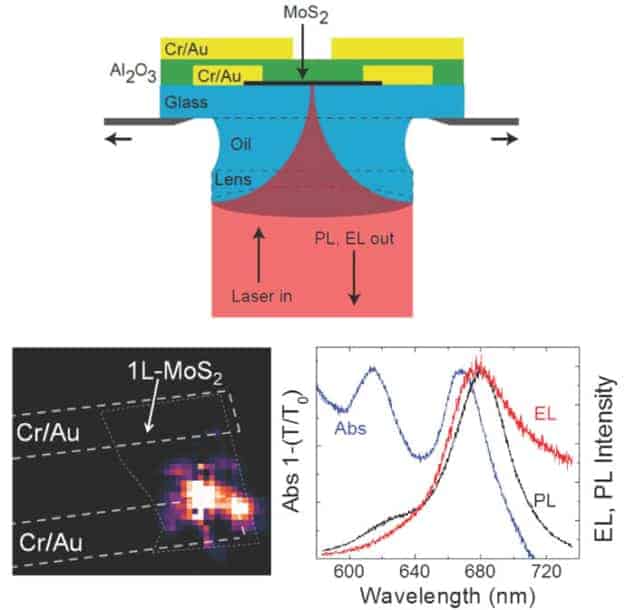
Transistors made from single-atom layers of semiconductor emit light when stimulated by an electrical current, according to new work by researchers in the UK, US and Germany. The discovery that 2D layers of molybdenite (MoS2) produce light suggests that it should be possible to build light sources and other photonic elements from layered 2D semiconductors such as molybdenite for use in future optoelectronics applications.
Molybdenite comprises 2D atomic layers that easily slip past each other, which is why the material is commonly used as a lubricant. As such it resembles graphite, which is made of 2D layers of carbon called graphene. Like graphene, molybdenite is a semiconductor with properties that could have significant technological relevance. However, unlike graphene (which has no band gap) and silicon, molybdenite is a direct band-gap semiconductor, which means that it should be very efficient at converting electrical energy into light and vice versa. As a result, the material could be used in devices such as LEDs, solar cells and photodetectors.
More useful properties
The fact that molybdenite has a band gap means that it could be better suited for making transistors than graphene – and the material also appears to have a high charge mobility that could be on par with state-of-the-art silicon. It should be compatible with a variety of substrates – even transparent or plastic ones. Finally, single-layer molybdenite is only about 0.65 nm thick, which means that very thin transistors could be made from it. However, the first molybdenite transistor was made in 2011 and researchers are just beginning to explore the properties of this semiconductor.
Now, a team of researchers led by Phaedon Avouris and Mathias Steiner of IBM’s Thomas J Watson Research Center in Yorktown Heights, New York, has shown that 2D molybdenite emits light when excited with an electrical current. Such band-gap-related light emission in 2D semiconductors is one of the most important and intensely researched topics in nanoscale science and technology, says Steiner, and the result confirms that it is possible to build light sources and other photonic elements from 2D semiconductors such as molybdenite.
Visible light emission
The team, which includes scientists Andrea Ferrari from the University of Cambridge in the UK and Ralph Krupke at the Karlsruhe Institute of Technology in Germany, obtained its results by passing an electrical current through a transistor containing single-layer molybdenite as the channel material. “By then using an optical microscope, we were able to detect light emission in the visible spectral range through the transparent substrate underneath the transistor,” says Steiner.
There is still much work to do, however, before real-world molybdenite optoelectronics become truly competitive with silicon, he adds. This is because the efficiency of the light emitted from the material is still relatively low. “Future research needs to address device design and explore novel gating techniques to improve light-emission yields and better control charge-carrier injection and extraction,” team member Ravi Shankar Sundaram says. “This might be done by using highly efficient gates to create electrostatic p–n junctions in the molybdenite channel, or by strongly doping the material with polymer electrolytes, for example.”
The current work is detailed in Nano Letters.



